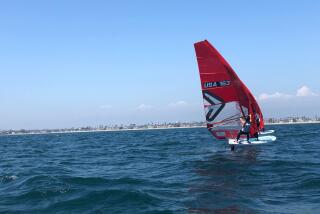New Zealand Is Magic Against San Diego Wind
- Share via
SAN DIEGO — According to the almanac, New Zealand is 20 hours ahead of Pacific Daylight Time. The Kiwis’ America’s Cup boat seems farther.
Amid 500 spectator boats tossed about in an uncomfortably rough sea in Race I of the best-of-nine America’s Cup finals, that old Black Magic did it again Saturday, treating Dennis Conner’s borrowed boat, Young America, no better than it had an outclassed fleet in the challenger trials when it finished first in 37 of 38 races by an average of 2 minutes 54 seconds.
Against Conner it was 2:45.
The Kiwis probably could have done it even without syndicate chief Peter Blake’s lucky red socks. The only time they finished second, he and his socks were off the boat.
Since then, most of the 3 1/2 million people in New Zealand have been wearing red socks. The official issue sold out at 100,000 pairs.
Is it too early to start printing the “New Zealand, Home of the America’s Cup” travel brochures?
Black Magic still must win four races, but it has eight chances to do it. The question is whether Conner’s Stars & Stripes crew can get its unfamiliar boat up to speed in time to win five.
“The reason we lost wasn’t because we didn’t know the boat,” Conner said. “We aren’t going to use it as an excuse.”
But it’s still a test drive for helmsman Paul Cayard.
“The boat’s really easy to steer,” he said. “It tracks well.”
But “it was a tough day when you really had to know your boat to sail well. We couldn’t have had a more difficult situation, with the waves and all.”
Typically for San Diego, the 6- to 8-foot swells and sharp chop after an early morning storm were out of proportion to the wind strength, which was a moderate 13 knots, dropping to eight at the end of the race. Although Conner’s crew had been working with Young America for a week, they hadn’t sailed it in those conditions.
They are hoping for those conditions again today, when no race is scheduled and they can get in some serious practice.
In pre-race jockeying, while Cayard tried to force the issue, Black Magic helmsman Russell Coutts steered his customary nonaggressive start, then in last few seconds before the gun, seized control of the right side of the course, which the Kiwis wanted.
Still Cayard, ahead and disturbing Black Magic’s wind, seemed to be in a strong position to bother the Kiwis, until Coutts simply worked Black Magic ahead, between Young America and the wind, in an impressive demonstration of power.
Coutts then prevented Cayard from breaking through to the right side on a series of tacks, and when Cayard chose to duck behind Black Magic, Coutts let him go, then came back, crossed Young America and tacked onto his wind at the layline, forcing Cayard to follow in his disturbed air to the mark, losing distance all the way.
Young America’s electronic instruments had gone out on that leg. “I wasn’t aware we were that close to the layline,” Cayard said. “We weren’t playing with a full deck there.”
Young America even had to sail by Whidden’s hand-held compass for a time.
Before the boat rounded the first mark, 31 seconds behind, Whidden said hopefully, “From what we’ve heard, they’re not that fast downwind.”
Sure enough, Young America cut the lead to 12 seconds--about two lengths--at the downwind mark, but Black Magic’s power told upwind.
“That’s what I expected,” said Doug Peterson, the San Diego-based marine architect who helped design the New Zealand boats. “They obviously have some teething problems. I don’t think a week was enough. You need a month to get a boat right. We’ve had more than four months. You could look at their mast . . . their rig position. The main (sail) didn’t look right.”
Cayard said he hopes it will look better when racing resumes Monday.
“I think we can make it a series,” he said.
More to Read
Sign up for The Wild
We’ll help you find the best places to hike, bike and run, as well as the perfect silent spots for meditation and yoga.
You may occasionally receive promotional content from the Los Angeles Times.





